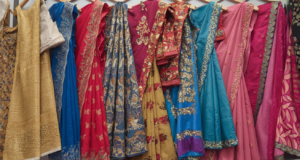Sarees are more than just garments; they are a rich representation of culture, tradition, and elegance. When you own an expensive saree made from luxurious fabrics like silk, chiffon, or georgette, taking proper care of it is essential to keep it looking stunning. This guide provides valuable tips and insights on maintaining and caring for your expensive sarees, ensuring they remain beautiful for years to come.
Ideal Storage Techniques
How you store your sarees can significantly affect their longevity. Here are some effective storage strategies:
Use Natural Fabrics
Always keep your sarees in breathable bags made from cotton or muslin. These materials protect the sarees from dust and moisture, while plastic covers can trap humidity and lead to mildew.
Gentle Folding
When storing, avoid sharp creases by rolling the saree or folding it in loose pleats. This practice helps to prevent unwanted creases and maintains the saree’s shape.
Dark and Cool Storage
Choose a dark and cool place for storage, away from direct sunlight. Sunlight can fade the vibrant colours of your saree over time.
Avoid Overcrowding
Ensure that your sarees have enough space in the storage area. Overcrowding can cause friction between fabrics, resulting in snags and other damages.
Cleaning and Washing Techniques
Proper cleaning is vital to keep your expensive sarees looking their best. Here’s how to go about it:
Check Care Labels
Always read the care labels for washing instructions. Certain sarees may need to be dry-cleaned, whereas others can be safely washed by hand.
Opt for Dry Cleaning
For silk sarees and those with heavy embellishments, dry cleaning is the best option. It gently cleans the fabric while preserving its quality.
Hand Wash if Possible
If your saree is labelled for hand washing, use lukewarm water and a gentle detergent. Avoid harsh chemicals or bleach, as these can harm the fabric. Soak the saree gently and use your hands to clean it without scrubbing too hard.
Thorough Rinsing
Rinse your saree thoroughly with cold water after washing to eliminate any detergent residue. This helps preserve the fabric’s softness.
Ironing and Pressing
Proper ironing can enhance the appearance of your saree. Here are some useful suggestions for proper ironing:
Set Iron to Low Heat
Always use a low heat setting on your iron to avoid scorching delicate fabrics.
Use a Protective Cloth
Place a thin cotton cloth between the iron and the saree to prevent direct contact. This extra layer protects the fabric from heat damage.
Steam for Best Results
If you can, use a steam iron. This method removes wrinkles without direct contact, preserving the fabric’s integrity.
Iron Slightly Damp
For optimal results, iron your saree when it is still slightly damp. This makes it easier to smooth out wrinkles and ensures a polished finish.
Careful Handling
Handling your saree with care is crucial to prevent damage. Here are some guidelines:
Avoid Heavy Accessories
When wearing an expensive saree, steer clear of heavy jewellery that can snag on the fabric. Instead, choose lighter accessories to minimize the risk of damage.
Be Cautious with Fragrances
Apply perfumes and lotions before putting on your saree. Direct contact with these products can leave stains on the fabric.
Mindful Eating and Drinking
Take care when eating or drinking while wearing your saree, as spills can be hard to remove, especially from lighter fabrics.
Regular Maintenance Practices
To extend the life of your sarees, engage in regular maintenance. Here are some practices to consider:
Air Them Out
Occasionally take your sarees out of storage and let them air out. This helps to keep them fresh and prevents any musty odors.
Inspect for Wear
Regularly check your sarees for signs of wear, such as loose threads or minor tears. Taking care of these problems quickly can help avoid additional damage.
Seek Professional Repairs
If you notice significant damage or intricate embroidery work needing attention, consider consulting a professional tailor who specializes in saree repairs. They can restore your saree to its original beauty.
Conclusion
Caring for expensive sarees requires a thoughtful approach, but the effort is worthwhile to maintain their elegance and charm. By following these guidelines for storage, cleaning, ironing, and careful handling, you can ensure your precious sarees remain in excellent condition for many years. Treating your sarees with love and attention will allow you to enjoy their beauty and heritage for generations to come.












